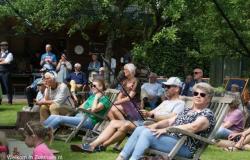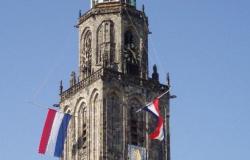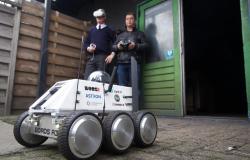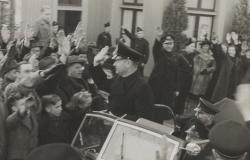
Zuidwolde commemorates one of the largest raids in the North with an exhibition, in which 148 men were sent to labor camps in Germany on April 25, 1944. Cees Vogel (90) saw how his father was arrested.
Sunday, April 23, 1944. In the reformed church in Zuidwolde, all the pews are occupied, as always. Reverend Luiks is in the pulpit. But this service is different. There are rumors that a roundup of the Germans is coming. And the pastor and some other men in prominent positions had better leave, because it is not impossible that they will be the first to be arrested.
Attack on Keijer prompted raid
The reason for the unrest is the attack on German-minded detective Jannes Luitje Keijer, who was shot at the station in Bedum on Saturday evening. The resistance thought he was becoming too dangerous. The Germans hit back hard the next day, with civilians who had nothing to do with the attack becoming the victims. The 53-year-old contractor Jannes Wiebe Formsma from Bedum is the first. He is taken to the Scholtenhuis, the headquarters of the German Security Service, and shot dead after interrogation.
The next day, the villages of Bedum, Winsum, Middelstum and Zuidwolde are surrounded by a thousand soldiers and police. “Our family then lived in the bridge keeper’s house in Zuidwolde,” says Cees Vogel (90) from Roden. “We had to operate the bridge over the Boterdiep.” He smiles at the memory. “We were allowed to keep the toll ourselves. We lowered a lump on a fishing rod and the skippers put the money in it.”
On Monday evening, April 24, 1944, there was a knock on the door. “Our neighbor Dirk van Ellen was at the door. He said: ‘I don’t need to know if Jo is at your house, but if he is, he shouldn’t go out, because everything around Zuidwolde has already been cordoned off. Jo was my brother who went into hiding with us to avoid being sent to Germany as a forced laborer.”
That night there is a knock on the door. “The Germans combed every house, looking for people they could use as forced labor. My brother was hiding in the attic. They didn’t find it, but even now I remember how scared I was. I was shaking in my bed.”
‘I’m going to milk those cows’
The next morning the raid is still in full swing. “All the men were gathered at café Hekma (the current café Moeke Vaatstra, ed.), we lived opposite it so we could see everything clearly. Of course we stayed inside, but eventually we heard our cows roaring. They were used to being milked in the morning. But yes, the cows were in a barn on the other side of the Boterdiep. Eventually my father could no longer bear it. He said: ‘I’m going to milk those cows’ and then went outside with a bucket. In the shed he met Mr Timmer, who had a drapery shop. He wanted to hide in the hay. My father was fine with that. A little later the barn was searched and they found Timmer. Both he and my father were taken to the cafe. I can still see him walking with his bucket of milk.”
He is silent for a moment. “Those were really anxious hours for us. Eventually we heard shots, but we didn’t know what was happening. It later turned out that they had shot dead Cees Bos, the servant of baker Dwarshuis.”
Harm Reinders (died in 1991) wrote about it in his book Attack and Reprisal . Reinders had also been arrested and was standing next to Bos. He tells how they had to make two hundred genuflections as punishment. ‘This assignment turned out to be fatal for Bos. He was wearing high boots, which made it impossible for him to bend his knees. They hit him with a cafe chair and dragged him backwards, out of the line, and took him into the drive-through. We heard one (or more) shots and later saw him, we were just standing at a window, with a white sheet on top, passing by on a cart.’
Teacher Hendrik Heys was shot dead
Baker Jan Dwarshuis, butcher Klaas Havinga and Jan Reinder Visser are also shot dead. Vogel: “We saw people being put in trucks, but we didn’t know what would happen to them.”
The baker’s body is found between Noordwolde and the Wolddijk. He was killed with a shot to the neck. Havinga’s body lies on the road between Wetsinge and Winsum, Visser’s on the Pijpsterweg. The same day, teacher Hendrik Heys was also shot dead in the door of his home in Middelstum.
Vogel: “We only heard much later that those men had been murdered. The village was completely defeated. We all knew each other. I played with the Visser children.” He sighs. “My father was released after a few hours.”
The bodies of Dwarshuis, Havinga and Visser are buried the following Saturday. “They are in the same grave. That’s what their families decided. The grave was arranged in such a way that there was also room for their wives.” Bos is buried in his hometown of Uithuizen.
22 Groningen residents will not return
During the raid in the four villages, 148 people were arrested. The prisoners from Bedum are gathered in Hotel Krijthe, those from Middelstum in the Lacum pub. The prisoners of Winsum are housed in Hotel Til.
Eight are released and the rest first leave for Camp Amersfoort. There are also hostages from Beverwijk and Sliedrecht here, who were also captured as a reprisal measure. In July 1944, a total of 650 prisoners left for labor camps in Germany. The conditions are terrible, a hundred succumb. Of the Groningen residents, 22 do not return.
Vogel stands again at the bridge keeper’s house. He looks at the café across the street, just like eighty years ago. People drink a cup of coffee on the terrace. “That’s where it happened, that’s where they were waiting. Crazy idea, right? I can still see my father walking home from the cafe. We were so very relieved. He still had the bucket of milk with him.”
Cap with bullet holes
The exhibition about the raid can be seen in the De Verbinding building in Zuidwolde from Thursday, April 25. This is partly an initiative of Sieger de Groot. At 5 p.m. there will first be a commemoration with a wreath laying at the plaque near the entrance to Café Moeke Vaatstra, where the hostages from Zuidwolde were taken on April 25, 1944. The exhibition at Pastorielaan 30 will be opened at 6 p.m. by G. Dijkinga, who survived the raid, and mayor Henk Jan Bolding. The exhibition includes photos and stories of the victims. There is also the cap with two bullet holes that butcher Havinga wore during the raid. The exhibition is freely accessible and open on Thursday April 25 (6 p.m. to 10 p.m.), Friday April 26 (10 a.m. to 10 p.m.) and Saturday April 27 (10:30 a.m. to 5 p.m.).
Tags: baker Dwarshuis murdered shot neck Zuidwolde commemorates raid Sieger Groot father arrested bucket milk
-




